You are here
The Photosynthesis Economy
Jeremy Rifkin stole the show at this week’s CERES 2012 Conference,” Igniting Innovation, Scaling Sustainability.” Amidst a line-up that included EPA Administrator, Lisa Jackson, Jack Ehnes, CEO of the California State Teachers Retirement System (managing $145 billion) and Carl Pope, sage of the environmental community and long-time head of the Sierra Club, Rifkin’s closing presentation was superior not for lack of competitors but rather for its range and scope. One could feel a ripple spread out across the 600-plus gathering of business and environmental leaders in Boston as we absorbed his opening assertion; the largest economy on earth is photosynthesis. In a TED-worthy presentation (and no slides) he then ran through a catalogue of facts and examples – from peak oil and species extinction rates, to economic cycles and renewable energy opportunities. (For more on Jeremy Rifkin's presentations, see his TED talk on "empathic civilization" and his collections on Vimeo and YouTube.)
Asserting that the Fall 2008 financial collapse was in fact an after-shock to the real economic earthquake that occurred July 2008 when oil reached $147 per barrel and the global economy began its downward spiral. Given the near ubiquitous presence of petroleum derived products in everything from fertilizer to pharmaceutical products, he makes a strong case that we have now entered a period where 5-6 year cycles of growth and retreat will repeatedly be triggered by oil prices surging into the range of $130-$140 per barrel. Despite the severe and systemic crisis he sees and a palpable sense of urgency – 40 years by his estimate before the window of opportunity closes – Rifkin also outlined six pillars (and more on each of these in future blogs) for an economic and environmental renaissance that are startlingly ambitious and quite logical.
- Acceleration in the production and use of distributed energy;
- Retrofitting of existing building stock to turn buildings into mini power plants;
- Utilization of hydrogen for batteries to store energy;
- Expansion of the smart grid as a transmission mechanism for energy; and
- Introduction of electric vehicle fleets replacing the internal combustion engine.
And Rifkin’s sixth pillar, a change in consciousness, is based on a provocative and compelling link he draws between how societies are organized and how the human brain evolves. In brief, he postulates that with each fundamental shift – from foragers to hunters and gathers, from rural agricultural societies to urban cultures – so too does the human brain evolve to account for closer, tighter, and more complex social interactions. And empathy, he asserts, not aggression or greed or competition, is at the core of evolving human consciousness. (For more on this see Rifkin’s fascinating tome, The Third Industrial Revolution: How Lateral Power Is Transforming Energy, the Economy, and the World.)
The need for a change in consciousness ran like an invisible thread through much of the conference in calls for more robust theories of change, the use of new tools such as the CERES AquaGauge and WRI’s Aquaduct, and Carl Pope’s quip to a smaller group that “natural gas is a potentially useful fuel afflicted with an abysmal industry.” And in many side discussions I exhorted people to marry facts with compelling narratives, to reframe the climate debate as a positive need for “climate stability,” and to refocus our thinking, planning and processes to embrace timetables that run well past the typical quarterly myopia that afflicts American industry.
As Pope, Jackson, Rifkin and many others observed there is increasingly no difference between environmental protection and economic prosperity. Future economic success, in Rifkin’s terms the “third industrial revolution,” (which interestingly is also the title of this week’s Special Report in The Economist), will be an environmental and energy revolution as well. Climate change is thus rightly seen not as an environmental challenge but rather as an economic issue – rife with risk and opportunity.
- jonathan.halperin's blog
- Log in or register to post comments

